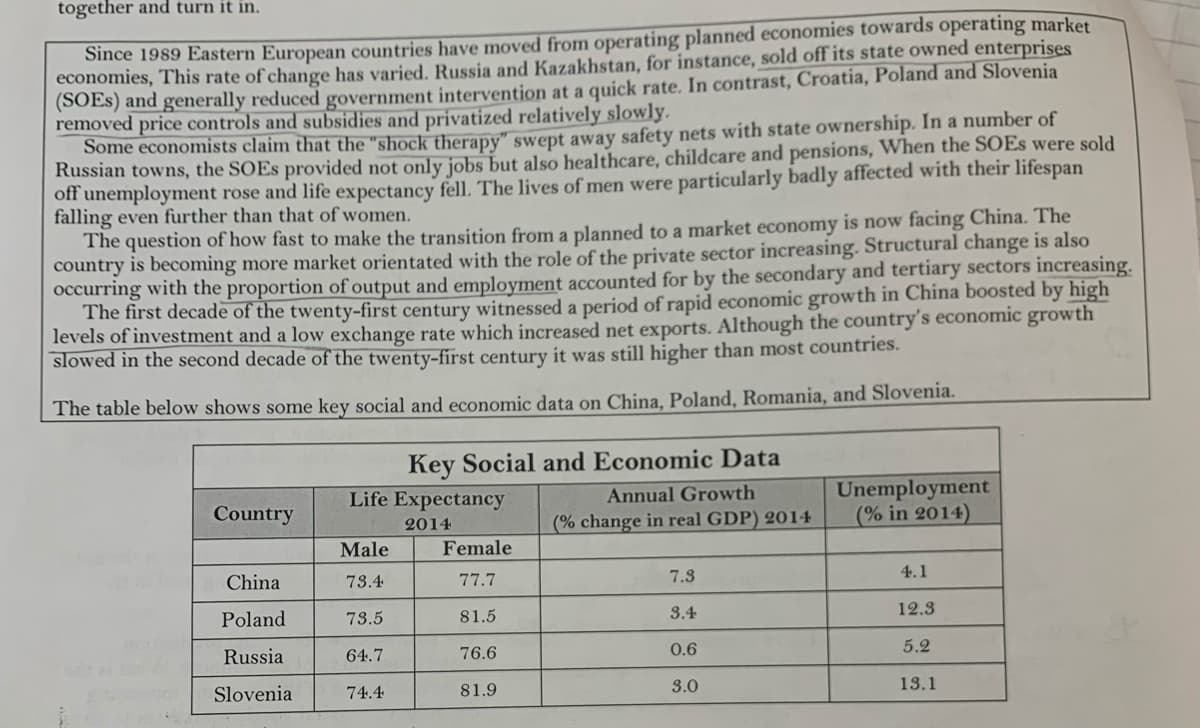Since 1989 Eastern European countries have moved from operating planned economies toward economies, This rate of change has varied. Russia and Kazakhstan, for instance, sold off its state owned enterprises (SOES) and generally reduced government intervention at a quick rate. In contrast, Croatia, Poland and Slovenia removed price controls and subsidies and privatized relatively slowly. Some economists claim that the "shock therapy" swept away safety nets with state ownership. In a number of Russian towns, the SOES provided not only jobs but also healthcare, childcare and pensions, When the SOES were sold off unemployment rose and life expectancy fell. The lives of men were particularly badly affected with their lifespan falling even further than that of women. The question of how fast to make the transition from a planned to a market economy is now facing China. The country is becoming more market orientated with the role of the private sector increasing. Structural change is also occurring with the proportion of output and employment accounted for by the secondary and tertiary sectors increasing. The first decade of the twenty-first century witnessed a period of rapid economic growth in China boosted by high levels of investment and a low exchange rate which increased net exports. Although the country's economic growth slowed in the second decade of the twenty-first century it was still higher than most countries. mg market The table below shows some key social and economic data on China, Poland, Romania, and Slovenia. Key Social and Economic Data Unemployment (% in 2014) Life Expectancy Annual Growth Country (% change in real GDP) 2014 2014 Male Female China 77.7 7.3 4.1 73.4 Poland 73.5 81.5 3.4 12.3 Russia 64.7 76.6 0.6 5.2 Slovenia 74.4 81.9 3.0 13.1
Since 1989 Eastern European countries have moved from operating planned economies toward economies, This rate of change has varied. Russia and Kazakhstan, for instance, sold off its state owned enterprises (SOES) and generally reduced government intervention at a quick rate. In contrast, Croatia, Poland and Slovenia removed price controls and subsidies and privatized relatively slowly. Some economists claim that the "shock therapy" swept away safety nets with state ownership. In a number of Russian towns, the SOES provided not only jobs but also healthcare, childcare and pensions, When the SOES were sold off unemployment rose and life expectancy fell. The lives of men were particularly badly affected with their lifespan falling even further than that of women. The question of how fast to make the transition from a planned to a market economy is now facing China. The country is becoming more market orientated with the role of the private sector increasing. Structural change is also occurring with the proportion of output and employment accounted for by the secondary and tertiary sectors increasing. The first decade of the twenty-first century witnessed a period of rapid economic growth in China boosted by high levels of investment and a low exchange rate which increased net exports. Although the country's economic growth slowed in the second decade of the twenty-first century it was still higher than most countries. mg market The table below shows some key social and economic data on China, Poland, Romania, and Slovenia. Key Social and Economic Data Unemployment (% in 2014) Life Expectancy Annual Growth Country (% change in real GDP) 2014 2014 Male Female China 77.7 7.3 4.1 73.4 Poland 73.5 81.5 3.4 12.3 Russia 64.7 76.6 0.6 5.2 Slovenia 74.4 81.9 3.0 13.1
ChapterA6: Appendix 6: Government Intervention During The Asian Crisis
Section: Chapter Questions
Problem 14DQ
Related questions
Question
Identify from the extract three indicators of an economy moving from a planned economy to a market economy.

Transcribed Image Text:together and turn it in.
Since 1989 Eastern European countries have moved from operating planned economies towards operating market
economies, This rate of change has varied. Russia and Kazakhstan, for instance, sold off its state owned enterprises
(SOES) and generally reduced government intervention at a quick rate. In contrast, Croatia, Poland and Slovenia
removed price controls and subsidies and privatized relatively slowly.
Some economists claim that the "shock therapy" swept away safety nets with state ownership. In a number of
Russian towns, the SOES provided not only jobs but also healthcare, childcare and pensions, When the SOES were sold
off unemployment rose and life expectancy fell. The lives of men were particularly badly affected with their lifespan
falling even further than that of women.
The question of how fast to make the transition from a planned to a market economy is now facing China. The
country is becoming more market orientated with the role of the private sector increasing. Structural change is also
occurring with the proportion of output and employment accounted for by the secondary and tertiary sectors increasing.
The first decade of the twenty-first century witnessed a period of rapid economic growth in China boosted by high
levels of investment and a low exchange rate which increased net exports. Although the country's economic growth
slowed in the second decade of the twenty-first century it was still higher than most countries.
The table below shows some key social and economic data on China, Poland, Romania, and Slovenia.
Key Social and Economic Data
Unemployment
(% in 2014)
Life Expectancy
Annual Growth
Country
2014
(% change in real GDP) 2014
Male
Female
7.3
4.1
China
73.4
77.7
Poland
73.5
81.5
3.4
12.3
Russia
64.7
76.6
0.6
5.2
Slovenia
74.4
81.9
3.0
13.1
Expert Solution
This question has been solved!
Explore an expertly crafted, step-by-step solution for a thorough understanding of key concepts.
Step by step
Solved in 2 steps

Knowledge Booster
Learn more about
Need a deep-dive on the concept behind this application? Look no further. Learn more about this topic, accounting and related others by exploring similar questions and additional content below.Recommended textbooks for you


Business/Professional Ethics Directors/Executives…
Accounting
ISBN:
9781337485913
Author:
BROOKS
Publisher:
Cengage


Business/Professional Ethics Directors/Executives…
Accounting
ISBN:
9781337485913
Author:
BROOKS
Publisher:
Cengage